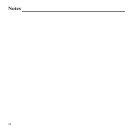
Care and Maintenance
3736
Aircraft Safety
• Power off your phone before the airplane takes off.
In order to protect the airplane’s communication
system from interference, it is prohibited to use
mobile phone in flight. If you want to use the mobile
phones before the airplane takes off, you should get
aircrew’s permission according to safety regulations.
• If the mobile phone has the function of automatic
timing power on, please check your alarm setting
to ensure that your phone will not be automatically
powered on during the flight.
Hospital Safety
• Switch off your phone and remove the battery in
areas where the use of handsets is prohibited.
• Follow the instructions given by the respective
medical facility regarding the use of handsets on
their premises.
Road Safety
• You must exercise proper control of your vehicle at
all times. Give your full attention to driving.
• Observe all of the recommendations contained in
your local traffic safety documentation.
• Pull off the road and park before making or
answering a call, if driving conditions require so.
• Check if local laws and/or regulations restrict the
use of handsets while driving.
• You MUST NOT stop on the hard shoulder of a
motorway to answer or make a call, except in an
emergency.
• Switch off your handset at a refueling point, such
as a gas station, even if you are not refueling your
own car.
• Do not store or carry ammable or explosive
materials in the same compartment as the handset.
• Electronic vehicle systems, such as anti-lock brakes,
speed control, and fuel injection systems are not
normally affected by radio transmissions. The
manufacturer of such equipment can advise if it
is adequately shielded from radio transmissions.
If you suspect vehicle problems caused by radio
transmissions, consult your dealer and do not switch
on the handset until it has been checked by qualified
approved installers.
Vehicles Equipped
with Airbag(s)
An airbag inflates with great force. Do not place
objects, including either installed or portable wireless
equipment, in the area over the airbag or in the airbag
deployment area. If in-vehicle wireless equipment is
improperly installed and the airbag inflates, serious
injury could result.
• Take care not to put your handset in the back pocket
of your trousers or skirt and then sit on it. Also, do
not put your phone at the bottom of a bag where
it may be subject to excessive weight or pressure.
Doing so may damage the LCD and camera lens and
cause them to malfunction.
• The operation of some medical electronic devices,
such as hearing aids and pacemakers, may
be affected if a handset is used next to them.
Observe any caution signs and the manufacturer’s
recommendations.
• Do not leave the handset discharged or without a
battery for a long time, otherwise some data may be
erased.
• Your phone contains metal, which may induce an
itch, a rash, or eczema, depending on your physical
condition.
CTIA Requirements
• Do not disassemble or open, crush, bend, or deform,
puncture, or shred.
• Do not modify or remanufacture, attempt to insert
foreign objects into the battery, immerse or expose
to water or other liquids, expose to fire, explosion, or
other hazard.
• Only use the battery for the system for which it is
specified.
• Only use the battery with a charging system that has
been qualified with the system per this standard.
Use of an unqualified battery or charger may present
a risk of fire, explosion, leakage, or other hazard.
• Do not short circuit a battery or allow metallic
conductive objects to contact battery terminals.
• Replace the battery only with another battery that
has been qualified with the system per this standard,
IEEE-Std-1725-2006. Use of an unqualified battery
may present a risk of fire, explosion, leakage, or
other hazard.
• Promptly dispose of used batteries in accordance
with local regulations.
• Battery usage by children should be supervised.
• Avoid dropping the phone or battery. If the device or
battery is dropped, especially on a hard surface, and
the user suspects damage, take it to a service center
for inspection.
• Improper battery use may result in a re, explosion,
or other hazard.
For those host devices that utilize a USB port as a
charging source, the host device’s user manual shall
include a statement that the phone shall only be
connected to CTIA-certified adapters, products that bear
the USB-IF logo, or products that have completed the
USB-IF compliance program.
Care and Maintenance


















